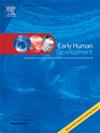罗宾序列儿童神经发育障碍:系统回顾和荟萃分析。
IF 2
3区 医学
Q2 OBSTETRICS & GYNECOLOGY
引用次数: 0
摘要
研究目的研究设计:研究设计:对 PubMed、Embase、CINAHL、APA PsycInfo、Emcare、MedNAR 和 Cochrane 图书馆等电子数据库进行了系统检索,检索时间从开始至 2024 年 5 月 31 日。其中包括报告 RS 患儿神经发育(整体、认知或运动)结果的研究。由两名独立审稿人使用标准化表格提取数据。采用随机效应荟萃分析法估算神经发育障碍的总体患病率和亚组特异性患病率(95% CI)。对三类 RS 进行了亚组分析:孤立型 RS(无其他相关异常)、综合征型 RS(与遗传综合征相关)和 RS 加型 RS(与非综合征先天异常相关):结果:共筛选出 2919 份记录。17项研究被纳入系统综述,其中16项研究(n = 1008)的数据被汇总进行荟萃分析。神经发育障碍的总患病率为 19%(12%-26%)。神经发育障碍在孤立型RS中的患病率为10%(5%至16%),综合型RS为19%(02%至44%),RS+型为63%(39%至84%)。非孤立型 RS(综合征和附加型)的总体患病率为 35%(22% 至 49%):这是首次系统回顾和荟萃分析报告 RS 儿童神经发育障碍的全球患病率。RS患儿是神经发育障碍的高危人群,应考虑对其进行长期的神经发育随访。这些发现将为临床医生对家长的咨询、资源分配提供指导,有助于制定基准,并能在未来的研究中评估治疗效果。本文章由计算机程序翻译,如有差异,请以英文原文为准。
Neurodevelopmental impairment in children with Robin sequence: A systematic review and meta-analysis
Objective
To estimate the global prevalence of neurodevelopmental impairment in children with Robin sequence (RS) at one year or more of age.
Study design
Electronic databases such as PubMed, Embase, CINAHL, APA PsycInfo, Emcare, MedNAR and Cochrane library were searched systematically from inception to 31st May 2024. Studies reporting on the neurodevelopmental (global, cognitive, or motor) outcomes in children with RS were included. Data was extracted using a standardized form by two independent reviewers. Overall and subgroup-specific prevalence (95% CI) of neurodevelopmental impairment was estimated with random-effects meta-analysis. Subgroup analyses were performed for three categories of RS: isolated (no other associated abnormalities), syndromic RS (associated with a genetic syndrome), and RS plus (associated with non-syndromic congenital abnormalities).
Results
A total of 2919 records were screened. Seventeen studies were included in the systematic review, of which data from 16 studies (n = 1008) were pooled for meta-analysis. The overall prevalence of neurodevelopmental impairment was 19 % (12–26 %). Neurodevelopmental impairment prevalence in isolated RS was 10 % (5 to16%), syndromic RS 19 % (02 to44%), and RS plus 63 % (39 to84%). The overall prevalence in non-isolated RS (syndromic and plus) was 35 % (22 to49%).
Conclusion
This is first systematic review and meta-analysis to report on the global prevalence of neurodevelopmental impairment in children with RS. Children with RS are at high risk of neurodevelopmental impairment and should be considered for long-term neurodevelopmental follow up. These findings will guide clinician counselling of parents, resource allocation, facilitate benchmarking, and enable the assessment of treatment impact in future studies.
求助全文
通过发布文献求助,成功后即可免费获取论文全文。
去求助
来源期刊

Early human development
医学-妇产科学
CiteScore
4.40
自引率
4.00%
发文量
100
审稿时长
46 days
期刊介绍:
Established as an authoritative, highly cited voice on early human development, Early Human Development provides a unique opportunity for researchers and clinicians to bridge the communication gap between disciplines. Creating a forum for the productive exchange of ideas concerning early human growth and development, the journal publishes original research and clinical papers with particular emphasis on the continuum between fetal life and the perinatal period; aspects of postnatal growth influenced by early events; and the safeguarding of the quality of human survival.
The first comprehensive and interdisciplinary journal in this area of growing importance, Early Human Development offers pertinent contributions to the following subject areas:
Fetology; perinatology; pediatrics; growth and development; obstetrics; reproduction and fertility; epidemiology; behavioural sciences; nutrition and metabolism; teratology; neurology; brain biology; developmental psychology and screening.
 求助内容:
求助内容: 应助结果提醒方式:
应助结果提醒方式:


